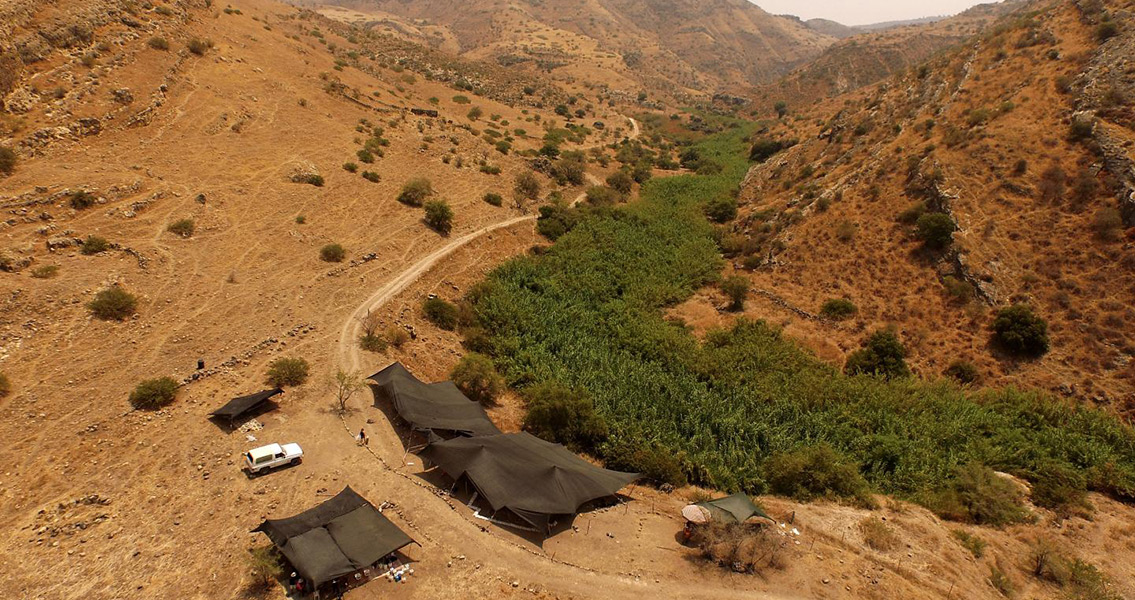<![CDATA[In the Jordan Valley, archaeologists with the Hebrew University of Jerusalem have recently excavated a settlement they claim may provide clarification regarding the shift of humans from a hunter-gatherer culture to an agricultural one. The prehistoric village lies in the middle of a perennial stream in Nahal (wadi) Ein-Gev which flows to the Sea of Galilee to the west. The village has been named NEG II and dates to around 12,000 years ago. What makes the site unique is the evidence being uncovered; it’s typical of both the Old Stone Age and the New Stone Age (also referred to as the Paleolithic and Neolithic periods), suggesting the settlement overlaps the two time periods. Researchers at the site have uncovered a plethora of findings, including flint tools, human burial remains, bone and ground stone tools, faunal assemblage (a group of animal fossils found together from the same time period) and art manifestations. The excavation has revealed cultural deposits 2.5m to 3m deep, which indicate an extensive habitation at the site, which is estimated to cover an area of 1,200 square meters. What distinguishes the two eras? The weather for one thing. The New Stone Age occurred as the Earth's climate was warming, though it’s never been determined exactly why it was warming, at the end of the last ice age. Simply put, along with the warmer climate, human and animal populations also rose and a moderate climate meant people and animals could stay in the same place - leading some groups to give up their nomadic lifestyle and settle. Homes became permanent residences and an agricultural culture (food and animal) was born. Dr. Leore Grosman, with the Institute of Archaeology at The Hebrew University of Jerusalem, who headed the excavations is reported as saying, "Although attributes of the lithic tool kit found at NEG II places the site chronologically in the Paleolithic period, other characteristics - such as its artistic tradition, size, thickness of archaeological deposits and investment in architecture - are more typical of early agricultural communities in the Neolithic period." "Characterizing this important period of potential overlap in the Jordan Valley is crucial for the understanding of the socioeconomic processes that marked the shift from Paleolithic mobile societies of hunter-gatherers to Neolithic agricultural communities," Dr. Grosman added. The village is the latest site discovered in the Levant region inhabited by the Late Natufian - the last culture in the Paleolithic period. The Natufian culture (which existed around 15,000 to 11,500 years B.P.) is known from archaeological sites across the Levant - from Lebanon and Syria in the north to the Sinai and the Negev in the south. The NEG II site was occupied within what is referred to as the Younger Dryas period; between 12,900 and 11,600 B.P., when global temperatures dropped dramatically causing Natufian populations in the Mediterranean to become increasingly nomadic and possibly smaller in number. Inexplicably, the findings at NEG II point towards a more sedentary and larger population. "The buildings represent at least four occupational stages and the various aspects of the faunal assemblage provide good indications for site permanence. In addition, the thick archaeological deposits, the uniformity of the tool types and the flint knapping technology indicate intensive occupation of the site by the same cultural entity," Dr. Grosman is quoted as saying. According to earlier statements, researchers claim this shift in settlement patterns may be because the Younger Dryas had a lesser effect on the region, resulting in overall better conditions associated with modest crop cultivation, providing the necessary ingredients for completing the final steps towards an agricultural society. Image courtesy of Austin (Chad) Hill ©Leore Grosman]]>
An Ancient Village By a Stream Bridges The Stone Ages
